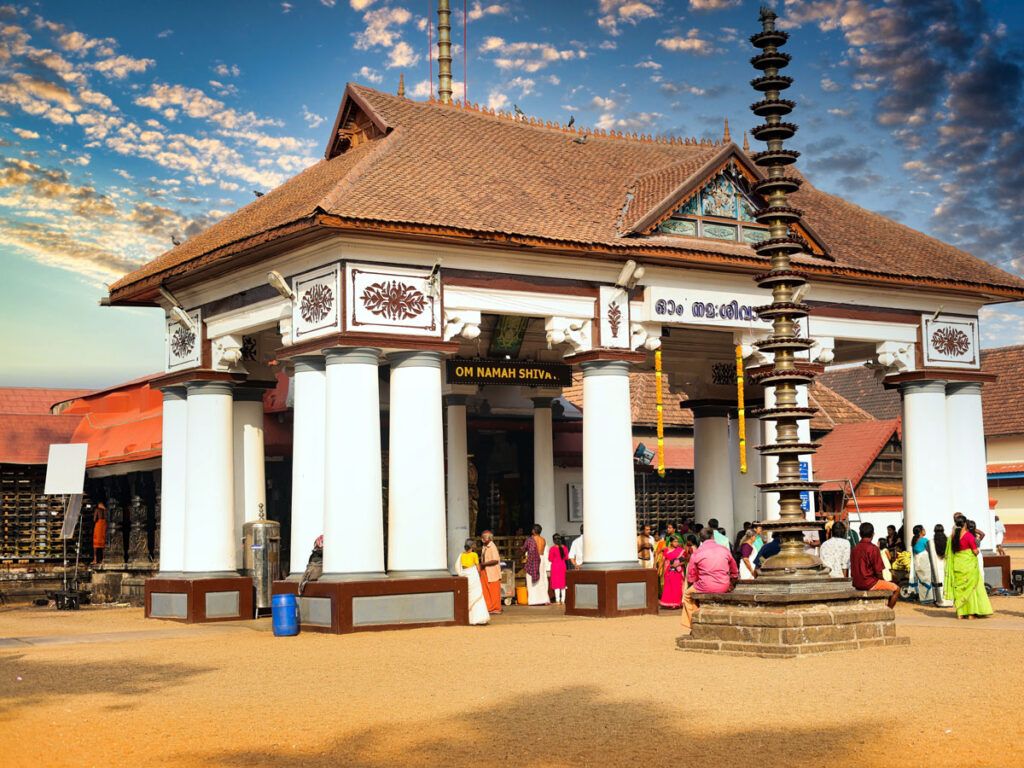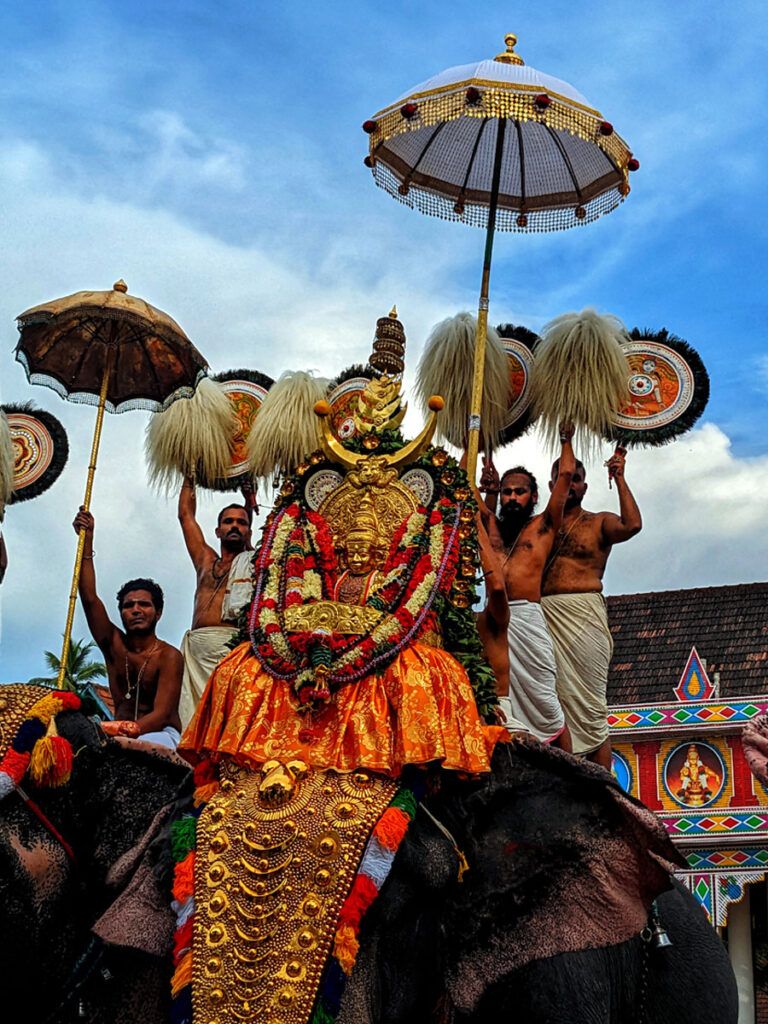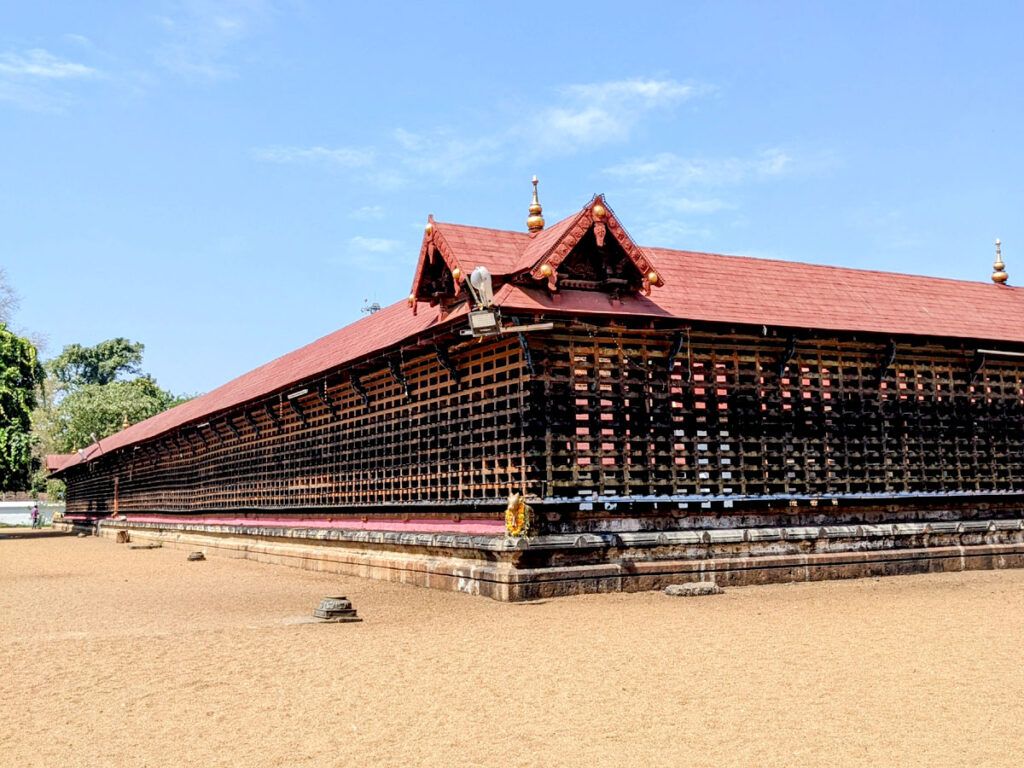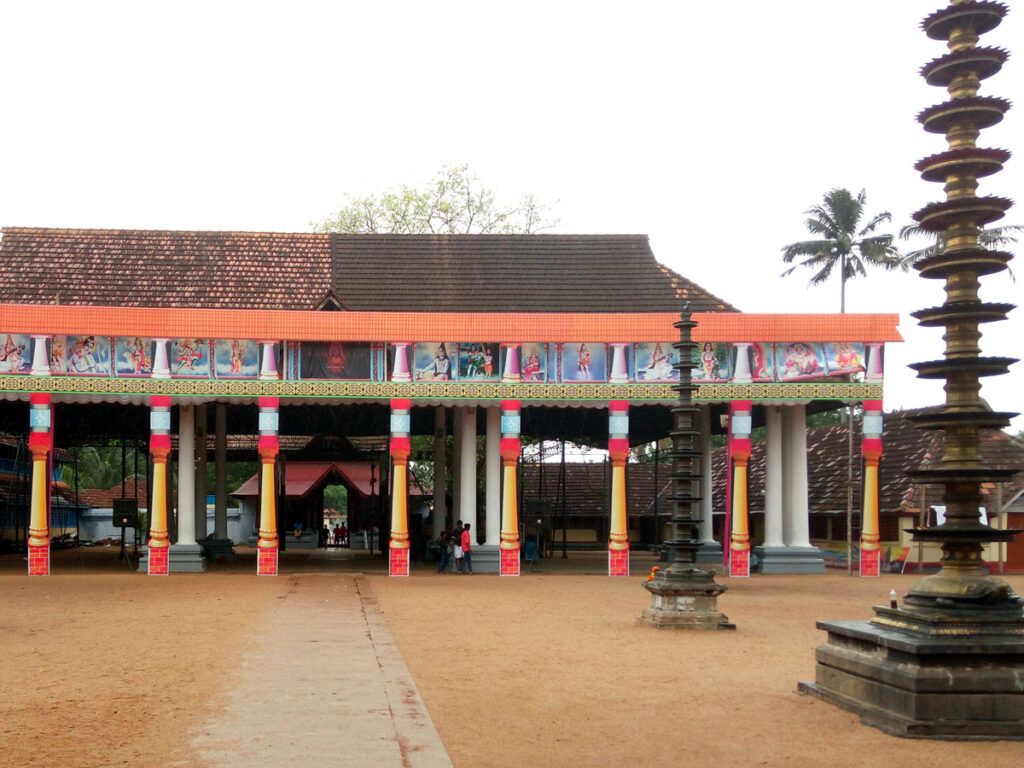Treta Yuga Vaikom Mahadeva Temple
The Vaikom Mahadeva Temple is a Hindu temple dedicated to Lord Shiva, located in the town of Vaikom in Kottayam district of Kerala, India. It is one of the oldest and most important temples in Kerala, and is considered to be one of the 108 Shiva temples in the Charoddesam of Kerala.

Contents
- 1 Vaikom Mahadeva Temple History:
- 2 Legend of Vaikom Mahadeva Temple:
- 3 Significance of Vaikom Mahadeva Temple:
- 4 Architecture of Vaikom Mahadeva Temple:
- 5 Myths and Beleifs at Vaikom Mahadeva Temple:
- 6 Vaikom Mahadeva Temple Timing and Rituals:
- 7 Festivals at Vaikom Mahadeva Temple:
- 8 Places to visit near Vaikom Mahadeva Temple:
- 9 FAQ:
- 9.0.1 What is the history of Vaikom Mahadeva Temple?
- 9.0.2 What are the main attractions of Vaikom Mahadeva Temple?
- 9.0.3 What are the dress codes for visiting Vaikom Mahadeva Temple?
- 9.0.4 What are the pujas and rituals that are performed at Vaikom Mahadeva Temple?
- 9.0.5 How can I get to Vaikom Mahadeva Temple?
- 9.0.6 What are the best places to stay near Vaikom Mahadeva Temple?
- 9.0.7 How old is Vaikom temple?
- 9.0.8 What is the Speciality of Vaikom?
- 10 How to reach Vaikom Mahadeva Temple:
- 11 Google Maps:
Vaikom Mahadeva Temple History:
The temple is believed to have been built in the Treta Yuga, the second age of Hinduism. According to legend, the temple was built by the asura (demon) Khara who was granted three Shiva Lingas by Lord Shiva himself. Khara was carrying the Lingas back to Kerala when he stopped to rest at the Vaikom site. When he tried to pick up the Lingas, they would not budge. Khara realized that this was a sign from Lord Shiva and he entrusted the Lingas to the sage Vyaghrapada who was meditating nearby. Vyaghrapada built a temple to house the Lingas and the temple has been in existence ever since.
The temple has been renovated and expanded several times over the centuries. The current structure dates back to the 16th century and was built by the Travancore royal family. The temple is a fine example of Kerala temple architecture and is a popular pilgrimage destination for Hindus from all over the world.
Read More>> Tirumala Tirupati Venkateswara Swamy Temple
Legend of Vaikom Mahadeva Temple:
The legend of Vaikom Mahadeva Temple is a story of devotion and perseverance. It tells the tale of a demon named Khara Asura who was granted three Shiva Lingas by the god himself. Khara Asura was a powerful demon who terrorized the land. He was so powerful that even the gods were afraid of him. One day, Khara Asura decided to challenge the gods. He went to the Himalayas and asked Shiva to give him three Shiva Lingas. Shiva agreed, but he warned Khara Asura that he would be cursed if he did not worship the Lingas properly.
Khara Asura took the Shiva Lingas and set off to conquer the world. He carried the Lingas in his hands, one in each hand and one in his mouth. As he traveled, he stopped at a place called Vaikom. He was tired and hungry, so he decided to rest for a while. He put the Shiva Lingas down on the ground and fell asleep.
While Khara Asura was sleeping, a sage named Vyaghrapada came to the temple. Vyaghrapada was a devout worshiper of Shiva. He saw the Shiva Lingas and immediately began to worship them. He prayed to Shiva for many hours, and his prayers were so sincere that they woke Khara Asura up.
Khara Asura was furious when he saw Vyaghrapada worshiping the Shiva Lingas. He woke up and tried to attack Vyaghrapada, but Vyaghrapada was protected by Shiva’s power. Khara Asura realized that he was no match for Vyaghrapada, so he fled.
Shiva was pleased with Vyaghrapada’s devotion. He appeared to Vyaghrapada and told him that he would remain in Vaikom to grant moksha to those who worshiped him. Shiva’s Linga is still worshipped in Vaikom today, and the temple is one of the most important Hindu pilgrimage sites in Kerala.
Read More>> Shirdi Sai Baba Temple Maharashtra

Significance of Vaikom Mahadeva Temple:
Religious Significance:
- Dedicated to Lord Shiva: It is one of the oldest and most important temples in Kerala dedicated to Lord Shiva. The Shiva Linga is believed to be from the Treta Yuga (the second age of humankind), making it a revered pilgrimage site for Shaivites.
- Three forms of Shiva: Devotees believe that Lord Shiva manifests in three forms here: Dakshinamurthy (morning), Kiratarmoorthy (afternoon), and Umajatha (evening), each offering specific blessings.
- Vaikathashtami festival: The annual Vaikathashtami festival celebrates the appearance of Shiva before Vyaghrapada, attracting thousands of devotees.
Historical Significance:
- Vaikom Satyagraha: The temple played a pivotal role in the Vaikom Satyagraha, a social reform movement that fought against untouchability in the early 20th century. The movement gained national attention and contributed to dismantling discriminatory practices.
- Architectural marvel: The temple boasts stunning Kerala-style architecture, with intricate carvings, gopurams, and a serene atmosphere.
Cultural Significance:
- Part of the “Char Dham” of Kerala: Vaikom Mahadeva Temple is considered one of the four sacred pilgrimage sites in Kerala, along with Sabarimala, Guruvayur, and Ettumanoor.
- Local traditions: The temple is intricately woven into the cultural fabric of Vaikom, with rituals like “Pallivettu” (offering palanquin) and “Kavadiyattam” (devotional dance) reflecting the region’s traditions.
Read More>> Shree Somnath Jyotirling Temple: The Shrine of Eternal Light

Architecture of Vaikom Mahadeva Temple:
The temple is built in the traditional Kerala style of architecture, with a circular sanctum sanctorum (sreekovil) surrounded by a series of courtyards and shrines. The sanctum sanctorum is roofed with copper sheets and has two chambers. The inner chamber houses the Shiva lingam, the sacred phallic symbol of Shiva. The outer chamber is decorated with murals depicting scenes from Hindu mythology.
The temple is surrounded by a high wall, with four gopurams (towers) at each of the four cardinal directions. The gopurams are decorated with elaborate carvings and sculptures, depicting scenes from Hindu mythology and religious symbols.
The temple is also home to a number of other shrines, dedicated to other Hindu gods and goddesses. These include shrines to Vishnu, Parvati, Ganesha, and Hanuman.
Read More>> Magnificent Ramanathaswamy Temple: A Marvel of Architecture
Myths and Beleifs at Vaikom Mahadeva Temple:
The Vaikom Mahadeva Temple in Kerala, India, is steeped in rich myths and beliefs that have captivated devotees for centuries. Here are some of the most fascinating ones:
Origin story:
- The Asura’s gift: One popular tale tells of Khara, an asura, who pleased Lord Shiva with his penance and received three idols as a reward. He carried them, one in each hand and one around his neck, but grew tired and rested them on the ground in present-day Vaikom. Shiva himself intervened, declaring the spot as his abode and transforming Khara into the Nandi, his bull mount.
- The celestial battle: Another legend recounts a fierce battle between Mahadeva and the demon king Andakasura. To weaken Andakasura, Mahadeva unleashed his divine fire, which consumed the demon’s chariot and landed on the earth, creating the Vaikom temple site.
Three incarnations of Shiva:
- Devotees believe that Lord Shiva manifests in three forms at the Vaikom temple:
- Dakshinamurthi (morning): The wise teacher, dispensing knowledge and wisdom.
- Kiratamurthi (afternoon): The fierce hunter, symbolizing the power to overcome obstacles.
- Shakti Panchakshari (evening): The embodiment of divine power and energy.

Other intriguing beliefs:
- Divine rivalry: Some locals believe in a playful rivalry between the Vaikom and Ettumanoor Shiva temples. Legend tells of a Maharaja offering eight elephants to the Vaikom deity, but the Ettumanoor god, jealous of the offering, caused snakes to appear on the elephants, preventing their delivery.
- Fulfilled wishes: Devotees believe that worshipping at all three temples – Vaikom, Ettumanoor, and Kaduthuruthy Shiva – before the Ucha puja grants all their desires.
- Serpent worship: The temple complex has a separate shrine dedicated to Nagas, the serpent deities, believed to ward off evil and protect devotees.
Unique significance:
The Vaikom Mahadeva Temple holds a special place in Kerala’s history and culture:
- Religious harmony: It is one of the few temples revered by both Shaivites and Vaishnavas, representing the harmonious coexistence of different Hindu sects.
- Vaikom Satyagraha: The temple served as a focal point for the famous Vaikom Satyagraha, a non-violent protest against caste discrimination in 1925.
Read More>> Sri Siddhivinayak Temple Rejinthal
Vaikom Mahadeva Temple Timing and Rituals:
Opening and Closing Timings:
- Morning: Opens at 4:00 AM or Saraswati Yama time (generally around 4:00 AM).
- Afternoon: Closes at noon for approximately 5 hours.
- Evening: Reopens at 5:00 PM and closes at 8:00 PM.
Important Rituals:
- Nirmalam: Cleansing ritual performed before the opening of the temple doors.
- Usha Pooja: Morning puja performed around 4:30 AM.
- Kalabham: Offering of water and milk to the deity.
- Abhishekam: Special puja involving bathing the deity with various substances like milk, honey, etc.
- Paada Pooja: Offering of flowers and incense at the feet of the deity.
- Deepaaradhana: Offering of light to the deity.
- Pushpanjali: Offering of flowers with folded hands.
- Neelambari: Musical offering performed on the veena in the evening.
Additional Information:
- Special Darshan: Certain days and occasions may have special darshan timings. Check the temple website or contact the temple for updates.
- Dress Code: Dress modestly, preferably in traditional Indian attire. Avoid shorts, sleeveless tops, and revealing clothing.
- Puja Booking: Certain pujas can be booked in advance. Contact the temple office for details or visit the official website https://www.vaikomtemple.org/

Festivals at Vaikom Mahadeva Temple:
The Vaikom Mahadeva Temple is one of the oldest and most important temples in Kerala, India. It is dedicated to Lord Shiva, and is known for its annual Vaikathashtami festival.
The Vaikathashtami festival is a twelve-day festival that takes place in the Malayalam month of Vrischikam, which corresponds to the months of November/December. The festival begins with the hoisting of the temple flag, and features a variety of rituals and ceremonies, including:
- Nandi Homam: A fire sacrifice performed in front of the Nandi statue.
- Bhadrakali Puja: A puja dedicated to the goddess Bhadrakali.
- Udayapuramappante Varavu: The arrival of Lord Muruga from the nearby Udayanapuram Subrahamanya Temple.
- Thidampu Vilakku: A procession of the Thidampu, a symbolic idol of Lord Shiva.
The festival culminates on the Ashtami day, which is considered to be a very auspicious day. On this day, the Thidampu is taken out in a grand procession through the streets of Vaikom. The procession is accompanied by music, dance, and fireworks.
The Vaikathashtami festival is a major cultural event in Kerala, and attracts pilgrims from all over the state. It is a time for celebration and worship, and is a reminder of the rich religious and cultural heritage of Kerala.
Read More>> Shree Aparna Devi Temple Bhabanipur Shaktipeeth Miracles
Here is a more detailed overview of some of the key events of the Vaikathashtami festival:
Nandi Homam:
The Nandi Homam is a fire sacrifice performed in front of the Nandi statue, which is located in front of the main temple. The homa is performed to propitiate Lord Shiva and to ensure the success of the festival.
Bhadrakali Puja:
The Bhadrakali Puja is a puja dedicated to the goddess Bhadrakali, who is the consort of Lord Shiva. The puja is performed to seek her blessings for the well-being of the people of Vaikom.
Udayapuramappante Varavu:
The Udayapuramappante Varavu is the arrival of Lord Muruga from the nearby Udayanapuram Subrahamanya Temple. Lord Muruga is the son of Lord Shiva, and is worshipped as a symbol of power and victory. His arrival at the Vaikom Mahadeva Temple is seen as a sign of good fortune.
Thidampu Vilakku:
The Thidampu Vilakku is a procession of the Thidampu, a symbolic idol of Lord Shiva. The Thidampu is a small, wooden idol that is covered in gold and silver ornaments. It is carried in a procession through the streets of Vaikom, accompanied by music, dance, and fireworks. The procession is a highlight of the Vaikathashtami festival, and attracts large crowds of spectators.
Read More>> Chintpurni Shakti Peeth: Where Wishes Find Fulfillment
Places to visit near Vaikom Mahadeva Temple:
- Ettumanoor Mahadeva Temple: This temple, dedicated to Lord Shiva, is located in Ettumanoor, which is not far from Vaikom. The temple is known for its impressive architecture and the presence of a golden flagstaff.
- Kumarakom: Famous for its backwaters, Kumarakom is a serene village situated on the Vembanad Lake. You can explore the Kumarakom Bird Sanctuary, take a houseboat cruise, or simply enjoy the natural beauty of the surroundings.
- Thalikkotta, Vaikom: This is a historic site located near the Vaikom Mahadeva Temple. It is associated with the Vaikom Satyagraha, a movement for temple entry rights in the 1920s.
- Kottayam: The nearby town of Kottayam offers several attractions, including the Thirunakkara Mahadeva Temple, the Ettumanoor Mahadeva Temple, and the Vembanad Lake. Kottayam is also known for its churches and rubber plantations.
- Vembanad Lake: This is the longest lake in India and offers stunning views and opportunities for boat rides. You can explore the backwaters and enjoy the tranquil surroundings.
- Aruvikkuzhi Waterfalls: Located near Kumarakom, Aruvikkuzhi Waterfalls is a picturesque waterfall surrounded by rubber plantations and lush greenery.
- Pathiramanal Island: This beautiful island in Vembanad Lake is a birdwatcher’s paradise. It’s a great place to relax and enjoy the natural beauty.
- Vaikom Beach: While in the area, you can visit Vaikom Beach to unwind and enjoy the coastal scenery.
- Kumarakom Backwaters: Take a backwater cruise in Kumarakom to experience the beauty of the interconnected rivers, lakes, and canals surrounded by greenery.
Read More>> Saptashrungi Bhadrakali Temple Nasik
FAQ:
What is the history of Vaikom Mahadeva Temple?
Vaikom Mahadeva Temple is one of the oldest temples in Kerala, dating back to the Treta Yuga, the second age of Hinduism. The temple is dedicated to Lord Shiva, and is one of the few temples in Kerala that is held in reverence by both Shaivas and Vaishnavas.
The temple is said to have been founded by Sage Parashurama, who is also credited with the creation of the land of Kerala. The temple is mentioned in the Sangam literature of the 3rd century BC, and is also mentioned in the writings of the medieval Hindu saint, Adi Shankaracharya.
The temple has been a center of religious and cultural activity for centuries. It is a popular pilgrimage destination for Hindus from all over Kerala and India.
What are the main attractions of Vaikom Mahadeva Temple?
The main attraction of Vaikom Mahadeva Temple is the Shiva Lingam, which is believed to be one of the oldest and most sacred Lingams in Kerala. The Lingam is six feet in height and is made of black stone. It is said to have been installed by Sage Parashurama himself.
The temple also has a number of other important shrines, including shrines dedicated to Vishnu, Parvati, Ganesha, and Hanuman. The temple also has a number of beautiful murals and sculptures that depict scenes from Hindu mythology.
What are the dress codes for visiting Vaikom Mahadeva Temple?
The dress code for visiting Vaikom Mahadeva Temple is simple and modest. Men should wear shirts and pants, and women should wear skirts or dresses that cover their knees. Visitors should also avoid wearing revealing clothing or clothing that is too tight.
It is also important to remove your shoes before entering the temple. Visitors can leave their shoes in the shoe racks provided at the entrance.
What are the pujas and rituals that are performed at Vaikom Mahadeva Temple?
A number of pujas and rituals are performed at Vaikom Mahadeva Temple throughout the day. The main pujas are performed in the morning (around 5:30 AM) and evening (around 7:00 PM).
Other pujas and rituals that are performed at the temple include:
- Abhisheka: A ritual in which water, milk, honey, and other liquids are poured over the Shiva Lingam.
- Archana: A ritual in which the Shiva Lingam is offered flowers, incense, and other offerings.
- Deeparadhana: A ritual in which lamps are lit in front of the Shiva Lingam.
- Yajna: A fire ritual that is performed to appease the gods.
How can I get to Vaikom Mahadeva Temple?
Vaikom Mahadeva Temple is located in the town of Vaikom in Kottayam district, Kerala. The temple is well-connected by road and rail.
By road, Vaikom Mahadeva Temple is about 2 hours from Kochi, the nearest major city. There are a number of buses and taxis that run from Kochi to Vaikom.
By rail, Vaikom Railway Station is located about 1.5 kilometers from the temple. There are trains that run from Kochi, Ernakulam, and other major cities to Vaikom Railway Station.
What are the best places to stay near Vaikom Mahadeva Temple?
There are a number of hotels and guesthouses located near Vaikom Mahadeva Temple. Some of the popular options include:
- Vaikom Palace Hotel
- Vaikom Central Hotel
- Vaikom Tourist Home
How old is Vaikom temple?
Vaikom Mahadeva Temple’s age is shrouded in mystery, with claims placing it in the Treta Yuga, one of Hinduism’s oldest ages, potentially making it thousands of years old. It’s considered one of Kerala’s oldest temples with a continuous history of worship.
What is the Speciality of Vaikom?
Spiritual Significance:
- Vaikom Mahadeva Temple: One of the oldest Shiva temples in Kerala, revered by both Shaivas and Vaishnavas. (Image of Vaikom Mahadeva Temple)
- Vaikom Satyagraha: A pivotal moment in India’s fight for social justice, where Mahatma Gandhi and others protested against caste-based discrimination through non-violent marches. (Image of Vaikom Satyagraha)
Historical Importance:
- Literary hub: Birthplace of renowned Malayalam writer Vaikom Muhammad Basheer, known for his poignant stories. (Image of Vaikom Muhammad Basheer)
- Ancient heritage: Mentioned in Sangam literature dating back centuries, showcasing its rich history.
Natural Beauty:
- Backwaters: Picturesque canals and serene waterways offer a peaceful escape and glimpse into Kerala’s rural life. (Image of Vaikom Backwaters)
- Paddy fields: Lush green landscapes and traditional farming practices provide a contrast to the temple town’s spiritual aura. (Image of Vaikom Paddy fields)
How to reach Vaikom Mahadeva Temple:
By Air:
The nearest airport to Vaikom is the Cochin International Airport (COK), which is approximately 76 kilometers away. From the airport, you can hire a taxi or use other modes of transportation to reach Vaikom.
By Train:
The nearest railway station is the Kottayam Railway Station, which is well-connected to major cities in India. From Kottayam, you can take a taxi or a bus to reach Vaikom, which is about 33 kilometers away.
By Road:
- From Kottayam: Vaikom is easily accessible from Kottayam by road. You can take a taxi, hire an auto-rickshaw, or use the state-run and private buses that ply between Kottayam and Vaikom.
- From Cochin (Kochi): Vaikom is around 35 kilometers from Kochi. You can reach Vaikom from Kochi by taking a bus or hiring a taxi.
- From Trivandrum: If you are coming from Trivandrum, the state capital, you can take a train or bus to Kottayam and then proceed to Vaikom.
Local Transportation:
Once you reach Vaikom, the temple is usually accessible by local transportation options like auto-rickshaws or taxis. The Vaikom Mahadeva Temple is a well-known landmark, and locals can guide you to its location.

One Comment